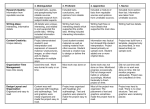The Art of CAMing: Belief Language v. Behavior Language
Adventure Girl here. Your one and only source into the risky lives of adventure’s elite!
Imagine you’re sitting and in front of you is your profesor or your boss, or whomever it might be. In their hand is one of your projects. The one you spent all semester on. The one you poured your heart and soul into. The one you’re incredibly proud of. As they slowly start to return it to you, you begin to see red markings. First you only see a few, faintly through the back of the paper, but as they lower the paper closer and closer to your desk, you begin to see more and more red marks, until you realize that the entire thing has one giant red scribble over it. “Terrible,” you hear them mumble as they set it on your desk. Dumbfounded, you decide to ask the logical question “What was so terrible about it?” They scoff at you. “The style of it was abysmal.” What??? Was the sty writing bad? Was the layout lacking of style? What was so wrong with it. Instead of asking about it, you simply let them walk away, thinking about what could possibly be wrong with your project.
writing bad? Was the layout lacking of style? What was so wrong with it. Instead of asking about it, you simply let them walk away, thinking about what could possibly be wrong with your project.
 writing bad? Was the layout lacking of style? What was so wrong with it. Instead of asking about it, you simply let them walk away, thinking about what could possibly be wrong with your project.
writing bad? Was the layout lacking of style? What was so wrong with it. Instead of asking about it, you simply let them walk away, thinking about what could possibly be wrong with your project.This is a perfect example of belief language. Belief language can be confusing, but you can simply think about it as the downfall of effective communication. Essentially, belief language is a vague description that could be interperated differently by anyone. Belief language is a lot of things but is especially these things:
-Adjectives.
At the core of any belief language is some non-descriptive adjective. Good, bad, hardworking, terrible, fantastic. Whatever the adjetive is, it can probably be interperated lots of different ways and can lead to miscomunication.
-Internal Judgements.
Although we may like to deny it, we hall have our own perspectives and biases on everything. Depending on when we’ve heard different words or phrases and our unique opinions on them, every word or phrase had different connotations for different people.
-Nearly impossible to act upon.
What feeds belief language is the inability for the person who’s hearing it to do anything about it. When we don’t know what it is we’re specifically supposed to do, it is impossible to act upon.
Belief language can be easy to use when not thinking, but it can lead to a lot of confusion. One time that belief language created a misunderstanding for me was in a history project a while back. The task seemed simple. All we had to do was make a poster listing a political party’s beliefs on five topics that we had been previously assigned. However, someone realized that the project would most likely be graded, so they spoke up and asked “How will this project be graded?”. It was a good question. Most teachers have some sort of rubric for assignments like these where they can simply list off what makes a good project and what makes a bad project. However, our instructions were different. We were simply told: “Have all of the facts on there and make it look good.” After hearing this, I automatically assumed that the project would be easy. I thought to myself if there’s this little guidelines, then all projects must receive good grades. It was an in class project, so I did my work on the project and I didn’t worry much about it. However, when I was later checking my grade on the portal, I found that I had only gotten a 4/5 on the assignment. Of course I was disappointed. I had thought this would be an easy 100, but instead I was left with a pathetic 80. I decided to go talk to the teacher about it to see what my project was missing. However, when I talked to him about it all he said was “Your project was good. Don’t worry about your grade.” All of what the teacher said to me in this scenario is a perfect example of belief language and why it doesn’t work. First of all, the guidelines were way to vague and clearly based off of belief. When my teacher said to make the project look good, he was probably thinking somewhere along the lines of using creative elements to make your project stand out. However, when I heard that the project was supposed to “look good” I thought it meant make neat lines and tittles, add a little bit of color, and try to make the writing legible. Next, when our teacher said “have the facts on there” I automatically assumed that it would just be the basic facts that we had already researched. However, the teacher was probably looking for something above and beyond what we had already done research on. Lastly, when I asked the teacher about my grade he used unclear belief language. In saying that my project was good and I should’t wory about my grade I had not clue what he meant. Did he mean that my project was good but not great, and I shouldn’t worry about it this time, but just make it great next time? If so, what did he consider great? Should my project have more images or more information? Was the layout not neat enough or was the layout too boring? It was also possible that he meant that he liked the project and I shouldn’t worry about the grade because my next project would get a good grade or that he might change the grade. Either way, it was hard to tell, because he only used belief language.
Imagine a world where only belief language exists, no one knows how to give instructions, and everyone else has absolutely no clue what to do. However, there is an alternative. This is called behavior language.
This scenario and many others probably would have worked better with behavior language instead of belief language. Simply put, behavior language is telling someone exactly what to do and how do do it. Like many others, I would have much rather preferred being told what to do instead of having to guess what to do based off of belief language. Some good ideas for the type of behavior language that could be used in this scenario is if the teacher had given us a specific rubric, listing off things like: include three images, use different colors, provide the information I had you research and an analization of it, and other specific details. By using behavioral language, it is very easy to improve the quality of instructions and decrease the likelyhood of miscommunication.

I understand that it can be hard to try to incorporate strange behavioral language into everyday instructions, but once it is incorporated, it is so much easier to understand people, and it will create a bond between the two people because of a mutual understanding. If you’re looking for easy ways to know if what you’re telling someone to do is behavioral or belief language, consider CAM. Is what you’re saying Consise? Do your instructions include exactly what you want done? How you want it done? If not, try to explain yourself better and make your words more consise. Another key to being consise is avoiding unecessary adjectives. Who really knows what “good” means in each context. Most likely the person you’re directing won’t understand what “good” means, so try to avoid unspecific words like it. Next, think to yourself, are my instructions Actionable? Could someone realistically act upon my instructions? Or would it be too hard for them with vague directions? Also, good instructions are something that the person could physically do. You can’t ask them to change how they act in general or in non-specific ways. Do you best to make you instructions implement actions to perform. Lastly, make sure that your instructions are measurable. Your instructions have to be exact, and if your instructions are Measurable, it should be easy for the person listening to your instructions to know if they did exactly what you wanted them to. They shouldn’t be left questioning if they followed your instructions correctly. Measurable doesn’t necesarily mean that there is a quantamtative result, the result you are aspiring for could easily be qualitative, but the extent needs to be clear if it is quantamtative.

In a study conducted with freshman students at the Alexander Dawson school where the goal was to have one person blindfolded who had to walk through a complex obstacle course and only way to navigate the course was a person guiding them through the course through spoken instructions, the study showed that behavior language was much more affective than belief language. In the end, belief language almost always lead to miscommunications or people stepping on obstacles that they shouldn’t have. For example, some students said things like “move your foot a little bit.” Because this is not CAM language, and it was hardly ever effective. However, some good language to use would be behavior language such as “move your foot up two inches, three inches forward, one inch to the left, then set it down.” These were great directions because they CAMed well. The directions were consise, expressing exactly what the director wanted to say, and nothing more. They were accionable, because they were easy for the person walking through the course to perform. Lastly, they were measurable, because they physically used a unit of measurement to determine if the person was following directions correctly.

Of course, it can also be incredibly frustrating when someone talks to you using belief language. However, an easy way to solve this problem is to that is to ask five simple words “What does that look like?” It may sound silly, but it can make the difference between you understanding behavior language, or you wrongly interpreting belief language.
So, next time if your giving advice or instructions. just remember to CAM. It’s that easy. And if you’re recieving advice, simply ask “what does that look like.” I hope that your future communications will be better!
You know you love me,
XOXO
Adventure Girl













